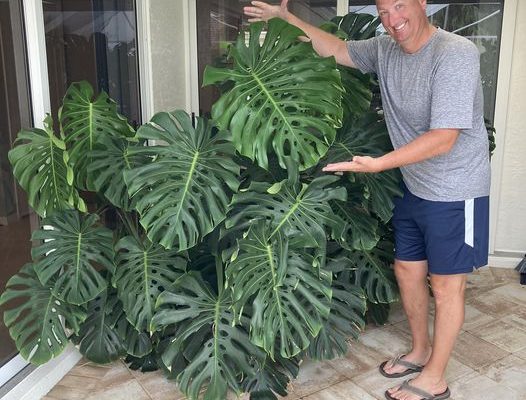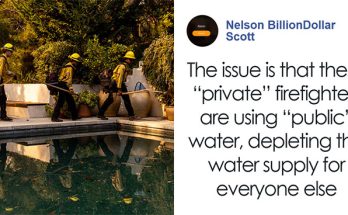Monstera, or Swiss cheese plant, is a tropical plant hailing from tropical regions in South and Central America, including southern California, Puerto Rico, Panama, and Mexico.
It can grow freely outdoors in USDA hardiness zones 10 and 12. In other areas, it can be grown outdoors in sheltered areas protected against frost
 Pin
PinTo grow Monstera outdoors, you must provide well-draining soil in an area that receives bright indirect sunlight for about 6 hours a day.
It can also do well in a setting where it receives dappled sunlight all day.
Outdoor Monstera Care Q&A
1. Can You Grow Monstera Outside In Hard Freeze Areas?
Monstera deliciosa will not survive the winter in very harsh cold and snow areas.
In these settings, it’s best to let your plant enjoy the warm months of spring and summer as a container plant outdoors and then bring it in before the first frost in the autumn.
2. What Temperature Ranges Are Best For Monstera?
The plant will do well outdoors in warm climates where nighttime temperatures never drop below 40° degrees Fahrenheit.
Likewise, it will thrive in areas with hot, sunny days and high humidity levels as they are native to tropical rainforests.
Kept as an indoor plant, your Monstera will probably be quite happy if your home is comfortable for you.
However, if you let your Monstera have a spring and summer vacation outdoors, you should bring it back in before nighttime cold temperatures fall below 50° degrees Fahrenheit.
TIP: Check and treat your Monstera for insect pests before bringing it back indoors for the winter.
Keep it separate from your other house plants until it is pest-free. Examples of common insects to keep a lookout for include mealybugs, spider mites, thrips, and aphids.
To control infestations, you can use insecticidal soap or neem oil.
3. When Should You Set Your Monster Outside For The Spring And Summer?
The precise timing will vary from one setting to another. But, generally speaking, when all danger of frost has passed in your area, you can begin transitioning your Monstera houseplant to its spring and summer setting.
Start by allowing it to sit in a sheltered, gently sunny location for a few hours a day.
Extend the amount of time, bit by bit. Keep a close eye on the condition of the plant.
If the Monstera develops brown (scorched) spots or begins to wilt, naturally, you should reduce the amount of time it spends outdoors and perhaps change its setting to provide a bit more shelter.
4. How Much Sun Should Outdoor Monsteras Receive?
Outdoors, most Monstera plants are rainforest plants that like to be in a reasonably shady setting.
Of course, a few hours of direct morning sun should be fine (depending upon your location), but for the most part, these forest dwellers will be happiest with filtered or dappled sunlight when vacationing outdoors.
They will also thrive in bright light and shade. Remember that direct sunlight can burn and wilt your Monstera plant.
5. Is It A Good Idea To Keep Monstera Outdoors Year Round In A Tropical Setting?
In areas where Monstera can thrive outdoors year round, they will grow rambunctiously and even produce some very delectable fruit.
However, you must ensure the outdoor plant is not considered invasive in your area before planting it.
Even if it is not listed as invasive, you must control its growth so that it doesn’t become invasive, as it has in Florida, Hawaii, and several other Pacific islands. [source]
6. How Do Invasive Monsteras Hurt The Environment?
A naturalized Monstera will spread rapidly by climbing, rambling, and sending out adventurous roots in a conducive setting.
Monstera vines will scramble up trees, covering them entirely and competing for light and resources.
Before you know it, a tree covered in Monstera will become a dead tree.
The plant rambles over the ground, smothering native plants. This kills the plants and any local fauna that may be dependent upon them for food.
7. How Can You Keep Outdoor Monstera Under Control?
It’s best to plant your outdoor Monstera plants in containers or enclosed raised beds to prevent them from rambling.
Prune regularly to prevent them from overwhelming surrounding plants and trees.
Take care not to drop cuttings on the ground because they will likely set roots and start growing.
8. What Kind Of Containers Are Best For Outdoor Monstera Plants?
These plants do best in plastic containers with plenty of drainage holes outdoors.
This is because plastic containers conserve water better than terra cotta, and potted plants dry out faster outdoors than indoors.
For this reason, it’s a good idea to keep your Monstera in terra cotta during the fall and winter indoors and in plastic during the spring and summer outdoors.
If you don’t want to bother repotting for spring and summer, you can set your terra-cotta pot inside a plastic pot with good drainage.
This will help prevent moisture loss through the sides of the terra cotta pot.
Remember, overly-moist soil caused by overwatering can result in root rot.
As for the fertilizer application, Monsteras need houseplant fertilizer or balanced liquid fertilizer every month to provide enough nutrients for deep roots and healthy growth.
9. Is It Better To Just Keep Monstera Indoors?
If you don’t live in a tropical climate, you needn’t worry about your plants’ invasive outdoor tendencies.
Even if a cutting takes root in the landscape during the summer, it won’t survive the winter.
Being outdoors for the summer is very beneficial for your houseplant.
Exposure to variable air circulations (breezes, not gales), natural sunlight, and rain will encourage excellent health and new growth.
10. What If My Plant Gets Damaged By Wind?
Don’t worry too much. Just prune away the damaged leaves and move your plant to a more sheltered area.
Where you’ve trimmed damaged growth, two new leaves will soon appear!



